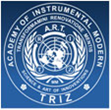MTRIZ
Today, the time is ripe for TRIZ.
The first generation worked out the basics,
even though it didn’t yet have the freedom
necessary for real research.
We need a second generation of TRIZ developers.
In this new stage of development, researchers are free to determine
what’s important and valuable
with the courage to reject what’s not.
Today, theory has already exceeded its name
but in the name of tradition it hasn’t yet been expanded accordingly.
Onward into a new stage of TRIZ!!
Genrikh Saulowitsch Altshuller Founder of TRIZ
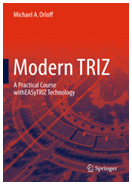

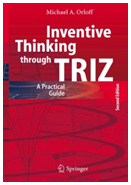

MTRIZ ADVANTAGES
The level of advantages of modern TRIZ is indicated by two markers:
EQ (Excellent Quality) - top quality, no analogues;
HQ (High Quality) - high quality, superior to any conventional counterpart.
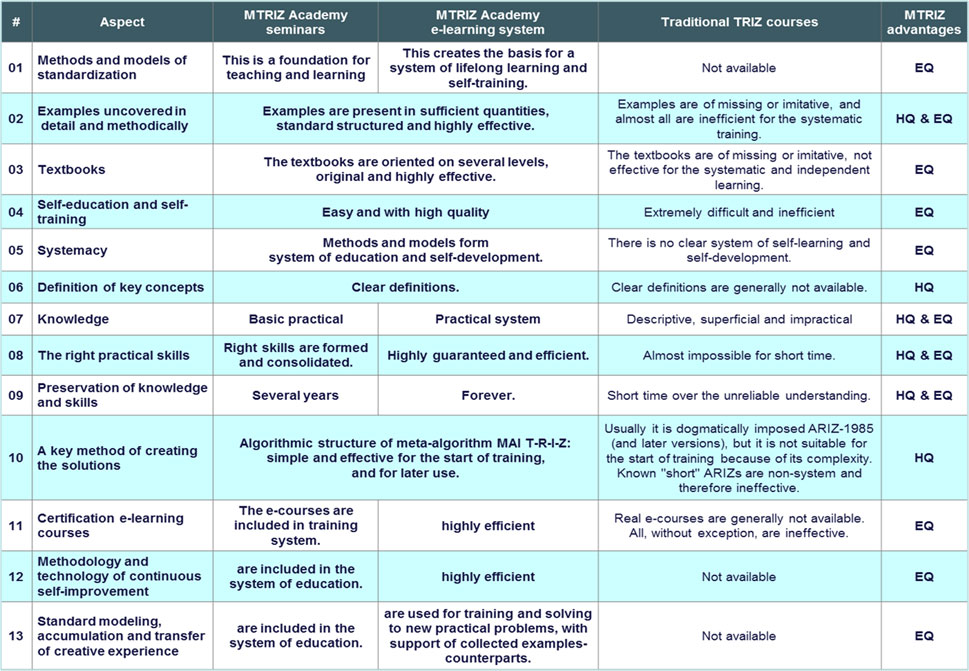
BASIC PILLARS OF MTRIZ
Well, today our question to us ourselves is: What is most important for TRIZ today?

Our answer is as following: the most important for current TRIZ is to ensure a mass-scale professional education in basic models of theory.
Therefore Modern TRIZ is designed to be used for education (including self-education) in these models as the point of origin in wide applying TRIZ.
The new TRIZ training technology must overcome the following known draw-backs:

- lack of an efficient introductory TRIZ training methodology,
- lack of generally accepted definitions for basic TRIZ concepts,
- lack of efficient standard examples to illustrate primary concepts and models.
Results of the "old-way" training with "folklore" talking method include the following:

- fuzzy understanding of the simplest models,
- lack of skills required to use the simplest models,
- unrealistic expectations from theory and practical tools (particularly the TRIZ software package),
- uncertainty, fear or inability to independently resolve practical problems.
Pathetic inefficiency of the "old" TRIZ teaching methods erects insurmountable barriers in the way of practical application of new knowledge and skills by most students as soon as they finish "traditional" workshops and seminars. The absence of sustainable skills required for error-free independent operation hamstrings them, dilutes their initial enthusiasm, and deprives them of the possibility to efficiently apply basic TRIZ knowledge in real-life situations.
Just to produce new impulse and push off a situation from dead point, the foundations of Modern TRIZ and education technology EASyTRIZ have been developed.

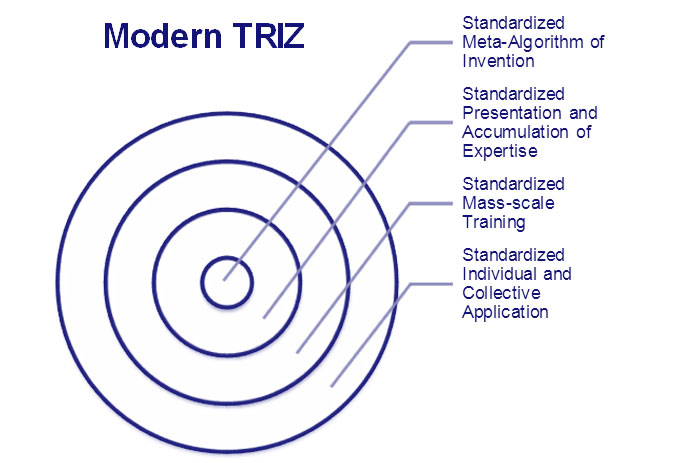
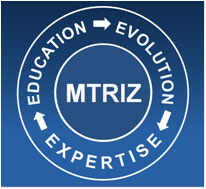
MTRIZ has to revise the empirical material containing the initial information about creative knowledge that has been objectively hidden in every artifact.
Every artifact was invented sometime!
And MTRIZ is aimed to reveal this objective knowledge as CREATIVE EXPERTISE.
To achieve this goal, it is necessary to gather thousands of inventions as it was realized by Genrikh Altshuller 50 years ago!
There is no other way to extract essential knowledge.
But the main difficulty lies not here.
The main obstacle was the lack of a clear concept for the systematization of creative knowledge.
Currently MTRIZ provides such system concept.
Extracting and Reinventing based on the Meta-Algorithm of Inventing is a modern "TRIZ-Tomograph" of inventive thinking.
It works like a "time machine": reinventing allows us to explore creative thinking of any inventor from any time and era!
Ruwim Kisselman,
PhD in engineering, inventor,
head of the Inventors Club "Schöpfer" ("The Creators" – German) from Bonn (Germany), organizer of the yearly seminars of the Modern TRIZ Academy in the German Museum in Bonn
Association of Inventor Clubs was created in Germany earlier within the framework of the INSTI Program; "INnovationsSTImulierung" was a state program
for the support of innovative movement in Germany;
www.deutsches-museum.de
Procedure of "Extracting" is a basement of (M)TRIZ. Purpose of extracting is "mining" of creative expertise from technical and other solutions.
Modern TRIZ achievement is to make structuring of this procedure and to standardize representation of information at all stages of creative transformations modeling.
It is necessary to distinguish two "contra-directional" processes in MTRIZ works.
First process is a mining of creative expertise and second one is applying the refined creative models.
Scheme of extracting the creative experience is shown below (here: C - contradictions; IFR – Ideal Final Result].
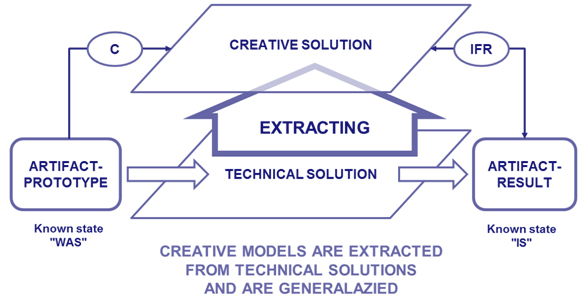
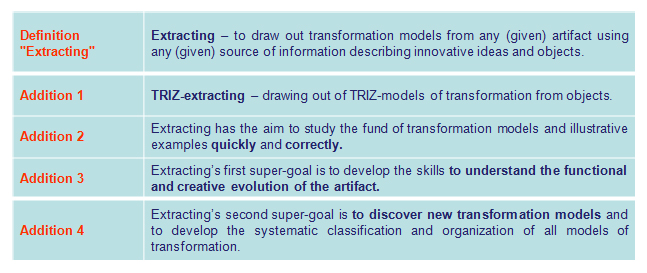
Procedure of “Reinventing" is a second basement of MTRIZ. Purpose of reinventing is to reproduce with modeling all the stages of creative transformations.
The content of reinventing is the reconstruction and description of all stages of an invention’s creation with involvement of models and recommendations of TRIZ for each stage of problem solving process.
To represent reinventing, the MAI T-R-I-Z is used. MAI T-R-I-Z generalizes FOUR main stage in modeling the process of invention and simplifies their representation for easy understanding and further applying also.
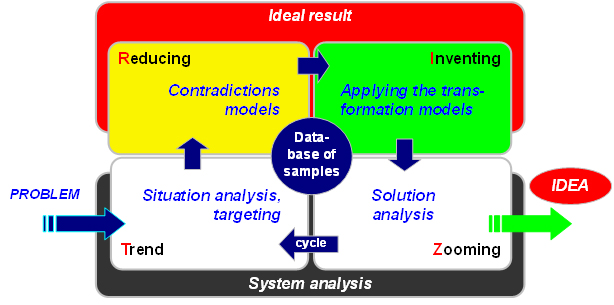
a) Meta-Algorithm of Invention T-R-I-Z (1995)

b) evolvent of MAI T-R-I-Z
When reinventing beginners are studying problems with known solutions which are illustrated in the MAI format in order to understand how these problems would have been solved on the basis of TRIZ and how in the future similar problems could be solved by using both, MAI as well as TRIZ.
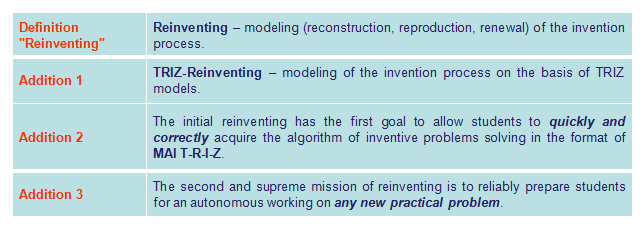
MAI is only a general frame and a general navigator for inventive problem solving and it becomes a practical instrument only in connection with models and methods of TRIZ which equip the stages of MAI and thereby turn it into a certain variant of ARIZ – Algorithm of Inventive Problem Solving.
Any invention could be represented in format of MAI T-R-I-Z. This is a base for standardization also.
Second MTRIZ process is an applying of creative expertise to problem solving (some key details are omitted by force).
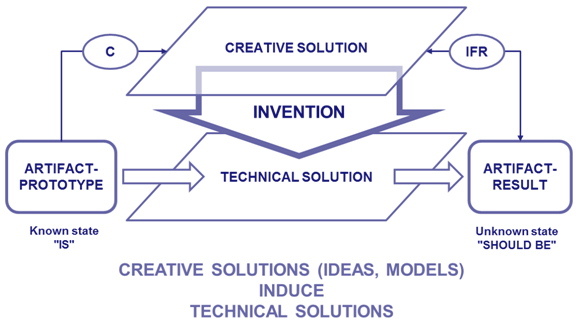
To learn in MTRIZ means to model idea generating with extracting and reinventing at MAI T-R-I-Z.
To invent in MTRIZ means to generate the ideas with TRIZ-models at MAI T-R-I-Z.
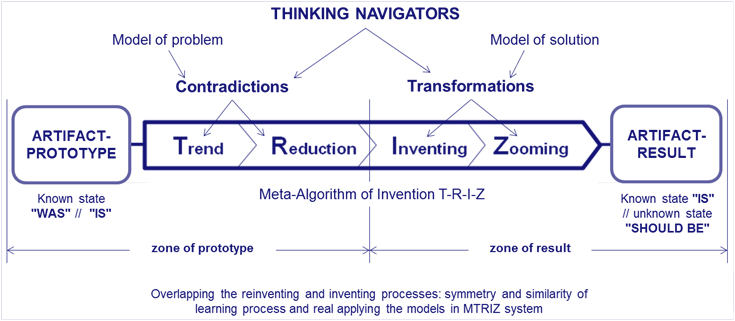

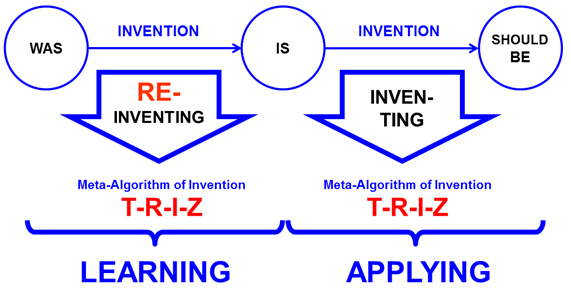

So, we have to extract the hidden creative knowledge from thousands of artifacts.
How could it be done?
Here we briefly consider a demonstration example to answer the question "How does MTRIZ work?"
Example: From simple pencil towards the mechanical one.
Any invention is a transition from the state of the object under improvement from the state "is" to the state "should be", or "must be".
The first state relates to the real object (as well as to any situation, process), having a specific construction (the structure, functioning, physical realization). Moreover, this construction has certain properties, at least one of which – the target – is required to improve.
The need for a transition to the second state is always associated with the requirement to achieve an improvement of a property that is defined as target.
The initial problem that it is necessary to change the existing construction, but nobody knows exactly how it should be changed. This situation contains general contradiction, or contradiction of the general type. In this conflict there is only a goal and there is no indication of the particular aspects interfering getting the desired target property.
Very often, when trying to change the prototype-construction, the standard contradiction occurs (standard problem): When trying to improve one property, another property deteriorates.
Another problem often encountered in a situation where, in order to improve some target property, there is not enough necessary resources, such as speed, strength, reliability, etc. Such situation can be summarized as follows: the target property must be achieved to improve the quality of the object, and should not be achieved, since there is no required resource. The essence of the root conflict situation generalized as situation of "to be or not to be" is defined as a radical contradiction.
When you sharpen a pencil, the black lead is uselessly lost to 90% of total mass. In addition, the body of a pencil is usually made of precious wood, and the tree is completely transformed into the trash.
General contradiction: how to reduce the loss of valuable wood and black lead on the fabrication of the pencil body?
Standard contradiction: a pencil must be sharpened (positive target feature: a sharp pencil tip for fine lines), but a lot of pencil lead is lost (negative property: the loss of the material) and usage period of pencil is reduced (as a negative feature).
Radical contradiction: a pencil has to be sharpened to make fine lines, and has not to be sharpened, not to lose lead and not to cut the pencil durability.
The invention of the mechanical pencil (both pencils are shown in fig. above): to remove all the contradictions was necessary to radically change the entire system: instead of a pencil with a wooden body and a relatively thick lead it was proposed a device with a metal casing containing a capsule with a lot of thin leads having a necessary working diameter, and a lead could be supplied by a special mechanism to exit the casing and fixed there for lines. Sharpen the pencil is not necessary.
There is no consumption of valuable wood. After using up a pencil, the remainder (approximately 10%) is released, and a new lead comes from the capsule to a mechanism for moving. After using up all the leads, the capsule is filled with new leads. The life of a pencil to depleting leads stock in the capsule is much longer than the life of a prototype-pencil.
Almost "perfect" result is obtained: minor lead loss, no consumption of precious wood, and still getting the above effect in the form of near-zero amount of time to "sharpen" lead by a simple extension of his body!
Creative solution models: an innovative solution, regardless of the will of the inventor – that is objectively (!) – contains a number of important models hidden in the technical solution and being its creative content, creative secret.
For example:
- "preliminary action" – the leads are "sharpened" in advance to a certain degree, and placed into the capsule in advance for future replacement,
- "segmentation" – separation of the pencil into parts (the body is separated from the lead, the lead is separated into several smaller leads),
- "replacement of mechanical matter" – the prototype construction with a solid one-piece core is replaced with a system that has special structure, mechanism, and moving parts,
- "dynamization" – the lead is made movable, there is a new mechanism which moves the lead and fixes it in working position, etc.,
- "inverse action" – do not sharpen the lead! Do not cut wood and not throw it in the waste!
- "discard and renewal of parts" – replacement of leads and replenishment of their stock,
- "matryoshka (nested doll)" – use of the inner capsule to house spare leads.
Leaving out the general deficiency associated with the loss of remaining lead, the outcome is this: lead loss – 0, time loss – virtually 0! Ideal result!
These and other models can be used to create new inventions. They can be applied to any object-prototype for improvement. This means that such creative models are universal. It is only necessary to identify a sufficient set of previously made effective inventions. This is the original fundamental idea of the TRIZ.
Modeling the inventive process: now that we have extracted transformation models and eliminated contradictions, the entire process of inventing the mechanical pencil can be squeezed into four major stages:
Stage 1. Trend. Identify deficiencies in the prototype artifact, and determine the direction (trend) of future changes. For example, what do we do to avoid sharpening the lead? This, as a minimum, points to the objective of improvement.
Stage 2. Reducing. Identify causes of the problem in the form of contradictions (see above). It becomes clear that attainment of the stated objective is contingent upon elimination of contradictions. Indeed, if we do not have to sharpen the lead, no time or material will be lost! Ideal Final Result!
Stage 3. Inventing. Key idea: make lead of the required diameter in advance! Also, to structure the pencil so that the user can extend the lead as necessary, and replace it with a new lead when it is spent. There are "segmentation", and "matryoshka", and "replacement of mechanical matter", and model "inverse action" here.
Stage 4. Zooming. Now, in the same way as we change focus and zoom in a camera, we need to review the result from various positions and levels of scrutiny. For example, at the level of the working element: the lead does not have to be sharpened! At the level of the pencil: the original contradictions have been eliminated. At the level of production: it is much simpler to manufacture the mechanical body and the leads separately. At the level of the user: time is saved, line weight is guaranteed, it is cheaper to use the mechanical pencil than keep buying ordinary pencils. At the level of the environment: precious wood is not wasted.
The first letters of the names of these stages make the abbreviation TRIZ, or T-R-I-Z. And the four stages comprise Meta-Algorithm of Invention T-R-I-Z, or shortly MAI T-R-I-Z.
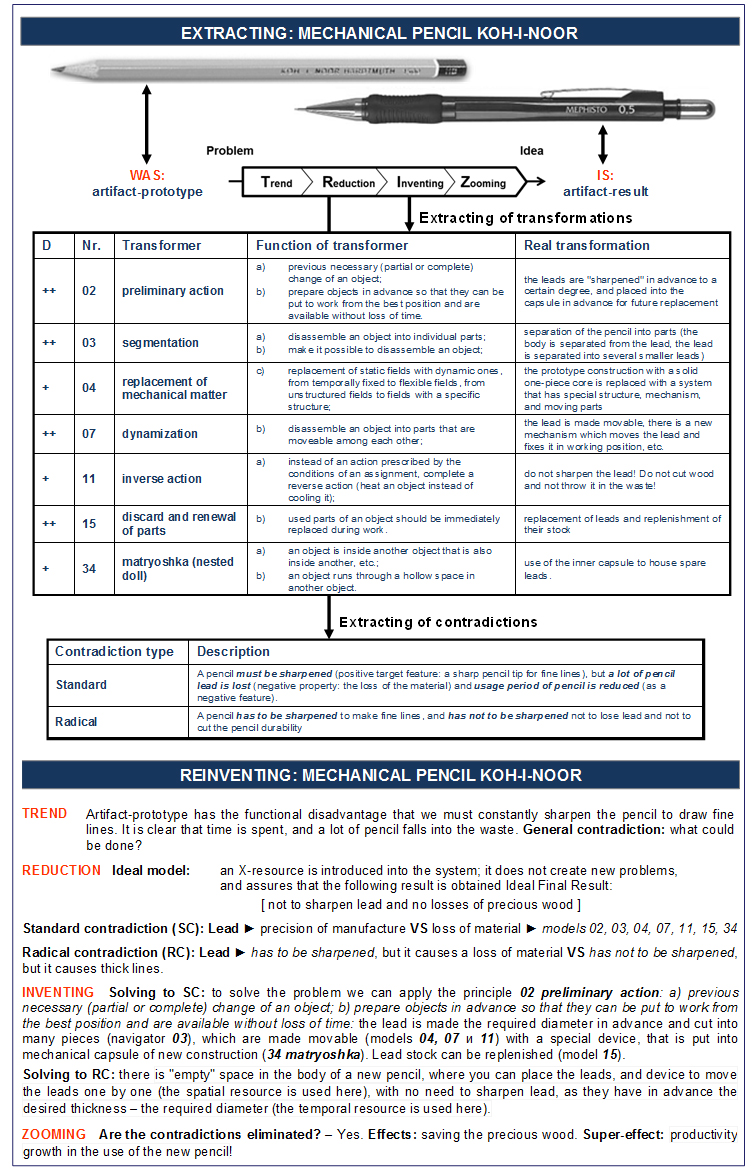
The aim of TRIZ is, and has always been, to learn to apply such basic models deliberately (as and when the authors want it!), in a purposeful and efficient manner.
The aim of Modern TRIZ is to assure mass-scale dissemination of TRIZ basics and efficient standardized application of TRIZ models, improve existing TRIZ models on an ongoing basis, and develop a general systemic and mathematical platform for the presentation of TRIZ theory.
To learn how to invent, you need to learn the basics of TRIZ.
First of all, you must:
1) examine the known creative models,
2) learn to formulate contradictions and
3) systematically use Meta-Algorithm of Invention T-R-I-Z (MAI T-R-I-Z).
And remember the saying of the founder of TRIZ, writer and inventor, as well as an outstanding teacher, Genrikh Altshuller:
TRIZ and "invention algorithms" do not replace talented thinking but help in it.
MTRIZ is irreplaceable to strengthen the talented thinking through systematic training the ability to analyze the effective solutions. Just this is an essence of Modern TRIZ research and teaching technology.
